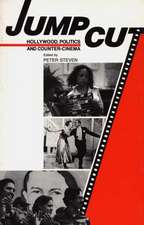Weimar Cinema – An Essential Guide to Classic Films of the Era
Autor Noah Isenbergen Limba Engleză Paperback – 5 feb 2009
| Toate formatele și edițiile | Preț | Express |
|---|---|---|
| Paperback (1) | 272.06 lei 6-8 săpt. | |
| Columbia University Press – 5 feb 2009 | 272.06 lei 6-8 săpt. | |
| Hardback (1) | 649.03 lei 6-8 săpt. | |
| Columbia University Press – 5 feb 2009 | 649.03 lei 6-8 săpt. |
Preț: 272.06 lei
Nou
Puncte Express: 408
Preț estimativ în valută:
52.07€ • 53.66$ • 43.96£
52.07€ • 53.66$ • 43.96£
Carte tipărită la comandă
Livrare economică 04-18 martie
Preluare comenzi: 021 569.72.76
Specificații
ISBN-13: 9780231130554
ISBN-10: 0231130554
Pagini: 368
Ilustrații: 95 illustrations
Dimensiuni: 151 x 226 x 28 mm
Greutate: 0.5 kg
Editura: Columbia University Press
ISBN-10: 0231130554
Pagini: 368
Ilustrații: 95 illustrations
Dimensiuni: 151 x 226 x 28 mm
Greutate: 0.5 kg
Editura: Columbia University Press
Cuprins
Acknowledgments
Introduction
1. Suggestion, Hypnosis, and Crime: Robert Wiene's The Cabinet of Dr. Caligari (1920), by Stefan Andriopoulos
2. Of Monsters and Magicians: Paul Wegener's The Golem: How He Came into the World (1920), by Noah Isenberg
3. Movies, Money, and Mystique, by Christian Rogowski
4. No End to Nosferatu (1922), by Thomas Elsaesser
5. Fritz Lang's Dr. Mabuse, the Gambler (1922): Grand Enunciator of the Weimar Era, by Tom Gunning
6. Who Gets the Last Laugh? Old Age and Generational Change in F. W. Murnau's The Last Laugh (1924), by Sabine Hake
7. Inflation and Devaluation: Gender, Space, and Economics in G. W. Pabst's The Joyless Street (1925), by Sara F. Hall
8. Tradition as Intellectual Montage: F. W. Murnau's Faust (1926), by Matt Erlin
9. Metropolis (1927): City, Cinema, Modernity, by Anton Kaes
10. Berlin, Symphony of a Great City (1927): City, Image, Sound, by Nora M. Alter
11. Surface Sheen and Charged Bodies: Louise Brooks as Lulu in Pandora's Box (1929), by Margaret McCarthy
12. The Bearable Lightness of Being: People on Sunday (1930), by Lutz Koepnick
13. National Cinemas / International Film Culture: The Blue Angel (1930) in Multiple Language Versions, by Patrice Petro
14. Coming Out of the Uniform: Political and Sexual Emancipation in Leontine Sagan's Mädchen in Uniform (1931), by Richard W. McCormick
15. Fritz Lang's M (1931): An Open Case, by Todd Herzog
16. Whose Revolution? The Subject of Kuhle Wampe (1932), by Marc Silberman
Filmography
Contributors
Index
Introduction
1. Suggestion, Hypnosis, and Crime: Robert Wiene's The Cabinet of Dr. Caligari (1920), by Stefan Andriopoulos
2. Of Monsters and Magicians: Paul Wegener's The Golem: How He Came into the World (1920), by Noah Isenberg
3. Movies, Money, and Mystique, by Christian Rogowski
4. No End to Nosferatu (1922), by Thomas Elsaesser
5. Fritz Lang's Dr. Mabuse, the Gambler (1922): Grand Enunciator of the Weimar Era, by Tom Gunning
6. Who Gets the Last Laugh? Old Age and Generational Change in F. W. Murnau's The Last Laugh (1924), by Sabine Hake
7. Inflation and Devaluation: Gender, Space, and Economics in G. W. Pabst's The Joyless Street (1925), by Sara F. Hall
8. Tradition as Intellectual Montage: F. W. Murnau's Faust (1926), by Matt Erlin
9. Metropolis (1927): City, Cinema, Modernity, by Anton Kaes
10. Berlin, Symphony of a Great City (1927): City, Image, Sound, by Nora M. Alter
11. Surface Sheen and Charged Bodies: Louise Brooks as Lulu in Pandora's Box (1929), by Margaret McCarthy
12. The Bearable Lightness of Being: People on Sunday (1930), by Lutz Koepnick
13. National Cinemas / International Film Culture: The Blue Angel (1930) in Multiple Language Versions, by Patrice Petro
14. Coming Out of the Uniform: Political and Sexual Emancipation in Leontine Sagan's Mädchen in Uniform (1931), by Richard W. McCormick
15. Fritz Lang's M (1931): An Open Case, by Todd Herzog
16. Whose Revolution? The Subject of Kuhle Wampe (1932), by Marc Silberman
Filmography
Contributors
Index
Notă biografică
Noah Isenberg is associate professor of University Humanities at Eugene Lang College-The New School, where he teaches literature, film, and intellectual history. He is the author, most recently, of Detour (British Film Institute, 2008).

















